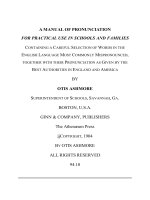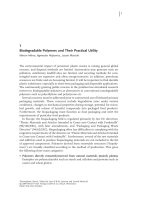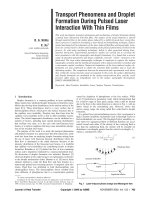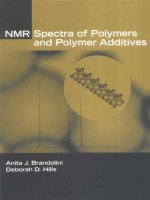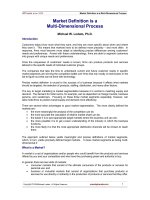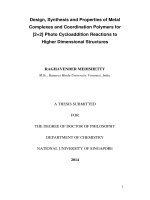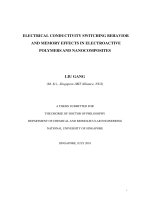Multi dimensional coordination polymers and rings containing trans, trans muconate anions with auxiliary ligands
Bạn đang xem bản rút gọn của tài liệu. Xem và tải ngay bản đầy đủ của tài liệu tại đây (10.99 MB, 239 trang )
MULTI-DIMENSIONAL COORDINATION POLYMERS
AND RINGS CONTAINING TRANS, TRANS-MUCONATE
ANIONS WITH AUXILIARY LIGANDS
MOHAMMAD HEDAYETULLAH MIR
(M. Sc., Indian Institute of Technology Madras, Chennai, India)
A THESIS SUBMITTED
FOR THE DEGREE OF DOCTOR OF PHILOSOPHY
DEPARTMENT OF CHEMISTRY
NATIONAL UNIVERSITY OF SINGAPORE
2010
II
Declaration
The work described in this thesis was carried at the Department of Chemistry,
National University of Singapore from 07
th
Aug 2006 to 12
th
July 2010 under the
supervision of Professor Jagadese J. Vittal.
All the work described herein is my own, unless stated to the contrary, and it
has not been submitted previously for a degree at this or any other university.
Mohammad Hedayetullah Mir
July 2010
III
Dedicated to my beloved parents specially to my mother
IV
Acknowledgements
I would like to take the opportunity to express my deepest gratitude to my
supervisor, Professor Jagadese J. Vittal for his invaluable guidance, positive criticism,
enlightening discussions and constructive suggestions throughout the candidature. His
valuable guidance helped me in attaining the scientific and scholarly attitude of a
researcher. I greatly admire his guidance and wish to express my sincere appreciation
for his constant moral and intellectual support, patience and supervision at each and
every stage of my PhD life.
I am grateful to my collaborator, Professor Ming Wah Wong, Richard and Dr.
Li Wang for theoretical studies. Their help and contribution were essential in this
work. I am thankful to Professor Susumu Kitagawa for adsorption studies.
I am thankful to my present and past group members for their moral support
and advices. Particularly, I would like to express my gratitude to Dr. Sudip, Dr.
Rakesh, Dr. Meng Tack, Dr. Tian Lu, Dr. Wei Lee, Dr. Mangayarkarasi, Abdul,
Saravanan, Goutam, Jeremiah, Raghavendar and Anjana for their invaluable support,
suggestions and motivation. Special thanks to Dr. Sudip for his help in making cover
picture.
I deeply thank to all the staffs in CMMAC laboratories and general office for
their assistance during these years. I would like to thank Professor Jagadese J. Vittal,
Ms. Tan Geok Kheng, Hong Yimain and Professor Koh Lip Lin for their help in X-
ray crystallography data collection and structure solution.
I am forever indebted to my parents, brothers, sisters and my beloved wife for
their caring, love, encouragements, continuous support and understanding. I would
like to thank all of my friends for their moral support.
Lastly, I thank National University of Singapore for research scholarship.
V
Table of Contents
Declaration II
Acknowledgements IV
Table of Contents V
Abbreviations and Symbols XI
Copyrights Permissions XIII
Summary XIV
List of Compounds Synthesized XVII
List of Figures XXIV
List of Schemes and Tables XXXI
Chapter 1. Introduction
1
1.1 Coordination Polymers
2
1.2 H
2
muco Ligand
7
1.2.1 Coordination Polymers of H
2
muco Ligand
8
1.2.2 Metal Macrocycles of H
2
muco Ligand
10
1.3 Water Clusters within Organic and Inorganic Hosts
11
1.4 Solid State [2+2] photodimerization
19
1.5 Aim and Scope of the Dissertation
28
Reference 30
Chapter 2. Porous 3D Coordination Polymers Built from Cu(II), Muconate
and Chelating Ligands: Interplay of Water Clusters of different
Morphologies
39
Preface to Chapter 2 40
Section 1 Trinuclear Copper(II) Diamondoid Coordination Polymer
Encapsulating Discrete Cyclic Water Heptamer
41
2.1.1 Introduction 42
2.1.2 Result and Discussion 43
2.1.2.1 Synthesis 43
VI
2.1.2.2 Description of crystal structure
[Cu
3
(phen)
3
(muco)
2
(H
2
O)
2
](BF
4
)
2
⋅5H
2
O, 1
43
2.1.3 Physicochemical Studies 48
2.1.3.1 IR spectra 48
2.1.3.2 Thermogravimetric analysis 48
2.1.3.3 Differential scanning calometric (DSC) studies 49
2.1.3.4 Variable temperature (VT)-single crystal X-ray studies 49
2.1.4 Summary 50
2.1.5 Experimental 50
2.1.5.1 Synthesis of Complex 50
2.1.5.2 X-ray Crytallography 51
Section 2 Influence of Anions on Structural Transformation of Water
Clusters
54
2.2.1 Introduction 55
2.2.2 Result and Discussion 55
2.2.2.1 Synthesis 55
2.2.2.2 Description of crystal structure
[Cu
3
(phen)
3
(muco)
2
(H
2
O)
2
](ClO
4
)
2
⋅5H
2
O, 2
56
2.2.3 Physicochemical Studies 59
2.2.3.1 IR spectra 59
2.2.3.2 Thermogravimetric analysis 59
2.2.3.3 Differential scanning calometric studies 60
2.2.4 Summary 61
2.2.5 Experimental 62
2.2.5.1 Synthesis of Complex 62
2.2.5.2 X-ray Crytallography 62
Section 3 Trinuclear Copper(II) Diamondoid Coordination Polymers
Hosting Water Helicate, (H
2
O)
7
66
2.3.1 Introduction 67
2.3.2 Result and Discussion 68
2.3.2.1 Synthesis 68
2.3.2.2 Description of crystal structure
[Cu
3
(bpy)
3
(muco)
2
(H
2
O)
2
](ClO
4
)
2
·5.5H
2
O, 3
68
2.3.2.3 Theoretical DFT calculation 72
VII
2.3.3 Physicochemical Studies 74
2.3.3.1 IR spectra 74
2.3.3.2 Thermogravimetric analysis 75
2.3.4 Summary 75
2.3.5 Experimental 76
2.3.5.1 Synthesis of Complex 76
2.3.5.2 X-ray Crytallography 77
References 79
Chapter 3 Pillared Layered 3D Coordination Polymers of Co(II)- and
Zn(II)-trans, trans-Muconate with bpe Spacer Ligand
84
Preface to Chapter 3 85
Section 1 One-Pot Synthesis of Dinuclear Cobalt(II) Interpenetrated
Coordination Polymers with Cubic Topology
86
3.1.1 Introduction 87
3.1.2 Results and Discussion 88
3.1.2.1 Synthesis 89
3.1.2.2 Description of crystal structures 89
3.1.2.2.1 {[Co(bpe)(muco)](DMF)(H
2
O)}
n
, 4 89
3.1.2.2.2 {[Co(bpe)(muco)(H
2
O)
2
](H
2
O)
3
}
n
, 5 92
3.1.3 Physicochemical Studies 95
3.1.3.1 IR spectra 95
3.1.3.2 Thermogravimetric analysis and thermal behavior 96
3.1.3.3 Powder X-ray diffraction 98
3.1.4 Summary 100
3.1.5 Experimental 100
3.1.5.1 Synthesis of Complex 100
3.1.5.2 X-ray Crytallography 102
Section 2 Single-Crystal to Single-Crystal Photochemical Structural
Transformations of Interpenetrated 3D Coordination Polymers by [2+2]
Cycloaddition Reactions
105
3.2.1 Introduction 106
3.2.2 Results and Discussion 107
3.2.2.1 Synthesis 107
VIII
3.2.2.2 Description of crystal structures
[Zn(bpe)(muco)]·(DMF)(H
2
O), 6
[Zn(bpe)(bdc)]·DMF, 7
[Zn(bpe)(fum)]·H
2
O, 8
107
3.2.2.3 Photodimerizatiuon reactions of compound 6 ‒ 8 in solid
state
110
3.2.3 Physicochemical Studies 114
3.2.3.1 IR spectra 114
3.2.3.2 Thermogravimetric analysis 115
3.2.3.3 Powder X-ray diffraction 116
3.2.4 Summary 119
3.2.5 Experimental 119
3.2.5.1 Synthesis of the complexes 119
3.2.5.2 UV irradiation of complexes 120
3.2.5.2 X-ray Crytallography 121
References 124
Chapter 4 Synthesis and Characterization of Metal Complexes of Muco
Ligand: Formation of 0D, 1D, 2D and 3D Coordination Polymeric
Structures
130
Preface to Chapter 4 131
Section 1 Metal-Salts and Coordination Polymers of Muconate Ligand
132
4.1.1 Introduction 133
4.1.2 Results and Discussion 134
4.1.2.1 Synthesis 134
4.1.2.2 Description of crystal structures 135
4.1.2.2.1 [Mg(phen)(H
2
O)
4
](muco), 12 135
4.1.2.2.2
[Co(NH
3
)
6
](muco)
⋅
Cl
⋅
2H
2
O, 13
136
4.1.2.2.3 [Cu
2
(tpy)
2
(muco)(NO
3
)
2
], 14 138
4.1.2.2.4
[Cu
2
(bpy)
2
(muco)
2
(H
2
O)
2
]
⋅
(H
2
O)
2
, 15
140
4.1.2.2.5 [{Cu(phen)(H
2
O)}
2
(muco)](NO
3
)
2
, 16 142
4.1.2.2.6
[Cu(4,4′-bpy)(muco)(H
2
O)
2
],
17
143
4.1.3 Physicochemical Studies 145
4.1.3.1 IR spectra 145
4.1.3.2 Thermogravimetric analysis 146
4.1.4 Summary 147
4.1.5 Experimental 148
IX
4.1.5.1 Synthesis of the complexes 148
4.1.5.2 X-ray Crystallography 149
Section 2 Coordination Polymers of Zn(II)/Cd(II), cis, cis-Muconate
Ligand and Bipyridyl Derivatives
155
4.2.1 Introduction 156
4.2.2 Results and Discussion 157
4.2.2.1 Synthesis 157
4.2.2.2 Description of crystal structures 157
4.2.2.2.1
[Cd
3
(cis, cis-muco)
3
(bpy)
2
], 18
157
4.2.2.2.2
[Zn
2
(cis,trans-muco)
2
(4,4′-bpy)
2
]
⋅
4H
2
O, 19
159
4.2.2.2.3 [Zn
2
(cis,cis-muco)
2
(bpe)
2
], 20 162
4.2.3 Physicochemical Studies 164
4.2.3.1 IR spectra 164
4.2.3.2 Thermogravimetric analysis 164
4.2.4 Summary 165
4.2.5 Experimental 166
4.2.5.1 Synthesis of the complexes 166
4.2.5.2 X-ray Crystallography 167
References 169
Chapter 5 Gold Macrocyclic Ring Structures of H
2
muco via Self-Assembly
171
Preface to Chapter 5 172
5.1 Introduction 173
5.2 Results and Discussion 178
5.2.1 Synthesis 178
5.2.2 Description of crystal structures 178
5.2.2.1
[Au
4
(dppm)
2
(muco)
2
]
⋅
2MeOH, 21
178
5.2.2.2
[Au
4
(dppe)
2
(muco)
2
]
⋅
2CH
2
Cl
2
⋅
MeOH, 22
180
5.2.3 Photodimerization of Complexes 21 and 22 in Solid-state 184
5.2.4 Photodimerization of Complexes 21 and 22 in Solution 189
X
5.3 Physicochemical Studies 190
5.3.1 IR studies 190
5.4 Summary 190
5.5 Experimental 191
5.5.1 Synthesis of the complexes 191
5.5.2 UV irradiation of complexes 192
5.5.3 X-ray Crytallography 193
Reference
194
Chapter 6 Conclusions and Suggestions for Future Work
196
Appendix
202
XI
Abbreviations and Symbols
Bpe trans-1,2-bis(4-pyridyl)ethene or 4,4′-bipyridyl ethene
Bpy 2,2′-Bipyridine
4,4′-Bpy 4,4′-Bipyridine
Calcd Calculated
CP Coordination Polymer
CH
2
Cl
2
Dichloromethane
CIF Crystallographic Information File
cis, cis-H
2
muco cis, cis-Muconic acid or cis, cis-1,3-butadiene-1,4-dicarboxylic
acid
cis, trans-H
2
muco cis, trans-Muconic acid, cis, trans-1,3-butadiene-1,4-
dicarboxylic acid
d Doublet
DMF Dimethylformamide
DMSO Dimethylsulfoxide
DSC Differential Scanning Calorimetry
EtOH Ethanol
Et
2
O Diethyl ether
FTIR Fourier Transform Infrared
fw Formula weight
h Hour
H
2
muco trans, trans-Muconic acid or trans, trans-1,3-butadiene-1,4-
dicarboxylic acid
H
2
fum Fumaric acid
H
2
bdc 1,4-Benzene dicarboxylic acid
XII
Ind. Independent reflections
IR Infra Red
MeCN Acetonitrile
MOF Metal-Organic Framework
MeOH Methanol
m Multiplet
Muconate trans, trans-Muconate or trans, trans-1,3-butadiene-1,4-
dicarboxylate
Muco
2-
trans, trans-Muconate anion or trans, trans-1,3-butadiene-1,4-
dicarboxylate anion
NMR Nuclear Magnetic Resonance
OAc Acetate
rctt-tpcb r-1,c-2,t-3,t-4-Tetrakis(4-pyridyl)cyclobutane
RT Room Temperature
s Singlet
SBU Secondary Building Unit
SCSC Single-Crystal to Single-Crystal
tpcb Tetrakis(4-pyridyl)cyclobutane
tpy 2,2';6',2"-terpyridine
TGA Thermogravimetric Analysis
THF Tetrahydrofuran
TMS Tetramethylsilane
UV Ultraviolet
VT Variable temperature
XRPD X-Ray Powder Diffraction
XIII
Copyright Permission
I sincerely acknowledge the publishers of Wiley-VCH Verlag GmbH & Co KG,
Royal Society of Chemistry (RSC), American Chemical Society (ACS) and Elsevier
B. V (ScienceDirect) for granting copyrights permission to reproduce the figures from
the respective journals as below. Permission has been granted for using the following
list of figures from various journals of the above mentioned publishers. Copyright
permission details are provided as a soft copy in the CD-ROM attached with this
thesis.
Copyrights permission from Wiley-VCH Verlag GmbH & Co KG
Figure 1.1 Angew. Chem. Int. Ed. 2004, 43, 2334. Copyright Wiley-VCH Verlag
GmbH & Co. KGaA. Reproduced with permission.
Copyrights permission from Elsevier B.V. (ScienceDirect)
Figure 1.6 Reprinted with permission from Inorg. Chem. Commun. 2006, 9, 371.
(Licence Number 2462940114096)
Copyrights permission from American Chemical Society
Figure 1.15 Reprinted with permission from J. Am. Chem. Soc. 2005, 127, 2798.
(Licence Number 2462881428699)
Figure 1.16 Reprinted with permission from J. Am. Chem. Soc. 2008, 130, 14064.
(Licence Number 2462901351765)
Copyrights permission from Royal Society of Chemistry
Figure 1.17 Reprinted with permission from Chem. Commun. 2009, 171. Royal
Society of Chemistry: Cambridge.
XIV
Summary
This thesis describes synthesis and structural studies of Cu(II), Co(II) and
Zn(II) metal coordination polymers as well as Au(I) metal-macrocycles. The
dissertation study focuses on (i) synthesizing coordination polymers of interesting
topologies, (ii) investigation of water clusters hosted by coordination polymers and
(iii) aligning the olefinic C=C bonds for photochemical [2+2] cycloaddition reaction
in the solid-state. The thesis has been divided into 6 Chapters.
The Chapter 1 provides the background research literature briefly to
understand the rest of the chapters in the thesis, reviews the recent developments in
coordination polymers, interesting water clusters of various architectures trapped in
the organic and inorganic crystal hosts, and finally the current challenges in
photochemical [2+2] cycloaddition reaction in the solid-state. At the end, the scope of
this thesis investigation is delineated.
The formation of water heptameric clusters of different morphologies within
Cu(II) coordination polymers is presented in the Chapter 2. This is divided into three
sections. Section 1 deals with the characterization of cyclic water heptamer, (H
2
O)
7
trapped in the 3D diamondoid coordination polymer formed from Cu(BF
4
)
2
, H
2
muco
and phen. When the single crystal is cooled from 296 K to 223 K, it undergoes SCSC
phase transition from monoclinic C2/c to P2
1
/c space group accompanied by
structural transformation of cyclic (H
2
O)
7
to bicyclic water heptamer containing edge
sharing pentamer and tetramer rings. Section 2 discusses the influence of anion in the
structural transformation of water heptamer in the crystal host by changing anion from
BF
4
¯
to ClO
4
¯. When the BF
4
¯
is replaced anion, the cyclic water heptamer
XV
transforms to another heptamer composed of cyclic pentamer ring buttressed by an
acyclic dimer via SCSC transformation. The encapsulation of water helicate by
changing the structure of the backbone of the coordination polymer from phen to a 2,
2′-bipyridine (bpy) ligand is described in Section 3.
Chapter 3 describes with the synthesis of coordination polymers of Co(II) and
Zn(II) metal with spacer ligands. This chapter is divided into two sections. Section 1
discusses two different 3D interpenetrated Co(II) coordination polymers in one-pot
reaction and pseudo supramolecular isomerism. In Section 2 synthesis and
photochemical structural transformations of three interpenetrated 3D pillar-layered
Zn(II) coordination polymers are discussed. Here the infinite pair of bpe ligands
acting as pillars undergoes 100% photochemical [2+2] cycloaddition reactions. Of
these two compounds were accompanied by SCSC transformation. This appears to be
the first example of 3D→3D SCSC structural transformation in interpenetrated 3D
coordination polymers induced by UV light. The corresponding pillar-layered
structure formed by fumaric acid and 1,4-benzene dicarboxylic acid are also found to
be photoreactive, confirming that this is a general phenomena in 3D network
structures.
Chapter 4 presents the synthesis and characterization of 0D, 1D, 2D and 3D
metal coordination polymeric structures of muco ligand. First section of this chapter
describes the coordination polymers of muco ligand and second section covers the
coordination polymers of cis, cis-muco ligand.
XVI
The final Chapter 5 contains the synthesis, X-ray crystallographic studies and
photodimerization reaction of two novel Au(I)-based macrocycles of diphosphine and
muco ligands where the C=C bonds of the adjacent muco ligands have been found to
be aligned (C=C center-to-center ≤ 4.0 Å) in a parallel fashion. However, only one
pair of C=C bonds undergo photodimerization of the two present in the ring. UV
irradiation of the Au(l) complexes led to the formation of the cyclooctadiene dimers
via Cope rearrangement instead of formation of ladderanes.
Finally, the thesis ends with an overall conclusion and offers scopes for further
investigations in this particular area of research.
XVII
List of Compounds Synthesized
No Compounds Structural units
1
[Cu
3
(phen)
3
(muco)
2
(H
2
O)
2
](BF
4
)
2
·5
H
2
O
3D diamondoid topology
2
[Cu
3
(phen)
3
(muco)
2
(H
2
O)
2
](ClO
4
)
2
·5
H
2
O
3D diamondoid topology
XVIII
3
[Cu
3
(bpy)
3
(muco)
2
(H
2
O)
2
](ClO
4
)
2
·5
H
2
O
3D diamondoid topology
4
[Co(bpe)(muco)]⋅(DMF)
⋅
(H
2
O)
3D cubic topology
XIX
5
[Co(bpe)(muco)(H
2
O)
2
]·4H
2
O
N
N
Co
H
2
O
H
2
O
N
N
O
O
O
OO
O
O
O
Co
Co
3D neb net
6
[Zn(bpe)(muco)]⋅(DMF)
⋅
(H
2
O)
3D cubic topology
XX
7
[Zn(bpe)(bdc)]
⋅
(DMF)
3D cubic topolgy
8
[Zn(bpe)(fum)]
⋅
(H
2
O)
3D cubic topology
9
[Zn(rctt-
tpcb)
1/2
(muco)]⋅(DMF)⋅(H
2
O)
3D cubic topology
XXI
10
[Zn(rctt-tpcb)
1/2
(bdc)]
⋅
(DMF)
3D cubic topology
11
[Zn(rctt-tpcb)
1/2
(fum)]
⋅
(H
2
O)
3D cubic topology
12
[Mg(phen)(H
2
O)
4
](muco)
Salt
13
[Co(NH
3
)
6
](muco)
⋅
Cl
⋅
(H
2
O)
2
Salt
14
[Cu
2
(tpy)
2
(muco)(NO
3
)
2
]
Dimeric complex
XXII
15
[Cu
2
(bpy)
2
(muco)
2
(H
2
O)
2
]
⋅
(H
2
O)
2
1D coordinational polymer
16
[{Cu(phen)(H
2
O)}
2
(muco)](NO
3
)
2
1D coordination polymer
17
[Cu(4,4′-bpy)(muco)(H
2
O)
2
]
3D CdSO
4
topolgy
18
[Cd
3
(cis,cis-muco)
3
(bpy)
2
]
2D (6,3 net)
XXIII
19
[Zn
2
(cis,trans-muco)
2
(4,4′-
bpy)
2
]⋅4H
2
O
2D (4,4 net)
20
[Zn
2
(cis,cis-muco)
2
(bpe)
2
(H
2
O)
2
]
O
O
O
O
Zn
N
N
Zn
N
N
OH
2
OH
2
O
O
O
O
1D coordination polymer
21
[Au
4
(dppm)
2
(muco)
2
]
⋅
MeOH
Macrocycle
22
[Au
4
(dppe)
2
(muco)
2
]
⋅
CH
2
Cl
2
⋅
MeOH
P
H
H
P
Au
Au
O
O
O
O
O
O
O
O
Au
Au
P
H
H
P
Ph
Ph
Ph
Ph
Ph Ph
Ph
Ph
Macrocycle
XXIV
List of Figures
Chapter 1
Figure 1.1
Components of coordination polymers (metal centres). 4
Figure 1.2
The formation of MOF by linking ZnO
4
tetrahedra with rigid
dicarboxylate bdc ligands leading to large void space (Left).
Perspective view of a {100} layer of the MOF shown along
the a-axis (Right)
5
Figure 1.3
The formation of cubic MOF by linking Zn
4
O(RCO
2
)
6
SBUs
connected by trans-stilbene linkers (Left). Space filling model
of two-fold interpenetration (Right).
6
Figure 1.4
Two isomers of muconic acid commercially available. 7
Figure 1.5
Structures of 1: (a) Bridging structure of muco ligands. (b)
Projection of the 3-D framework onto the ab plane.
8
Figure 1.6
Coordination environment of Ni(II) ion in compound
[Ni(muco)(4,4′-bpy)(H
2
O)
2
]
n
. A representation of the modes
of inclined interpenetration by complementary (4, 4) networks
for [Ni(muco)(4,4′-bpy)(H
2
O)
2
]
n
.
9
Figure 1.7
A representation of 1D coordination polymer,
[Zn(muco)(H
2
O)
2
]
n
. b) A perspective view of 3D hydrogen
bonding network.
9
Figure 1.8
A perspective representation of the [Zn(4,4'-
bpy)(H
2
O)
4
]⋅(muco) coordination polymer.
10
Figure 1.9
Pt-based molecular a) triangle and b) rectangle with muco
ligand.
10
Figure 1.10
Water tetramer in its immediate environment (Left). Planer
water tetrameric cluster (Right).
13
Figure 1.11
Representation of the cyclic water pentamer (Left). Water
tape consisting cyclic water penramers (Right.
13
Figure 1.12
Planar cyclic discrete water hexamer cluster trapped in an
organic crystal host matrix.
14
Figure 1.13
An ice-like, cyclic (H
2
O)
8
cluster in the solid-state structure of
an organic supramolecular complex.
15
Figure 1.14
Ice I
c
-like
water decamer anchored by two Cu(II) atoms in a
solid-state structure.
15
Figure 1.15
X-ray crystal structure of (H
2
O)
10
within the cage (Left).
ORTEP drawing water (H
2
O)
10
(Right).
16
Figure 1.16
(H
2
O)
12
cluster present in the metal-organic nanotube. 16
Figure 1.17
(a) Topology of the (H
2
O)
32
cluster with S
6
symmetry. (b) Top
view of the water cluster with surroundings.
17
Figure 1.18
Display of helical water chain encapsulated (left). Hydrogen
bonded helical water chain with space filling model (right).
17
Figure 1.19
Two-dimensional infinite ice layers in at 20 K. 18
Figure 1.20
Diagram of 2(res)·2(4,4′-bpe) co-crystal. 21
Figure 1.21
Diagram of 2(res)·(4,4′-tpcb) cocrystal. 21
Figure 1.22
Schematic representation of the photoreaction of [Cp*
4
Rh
4
(µ- 22
XXV
bpe)
2
(µ-η
2
-η
2
-C
2
O
4
)
2
](OTf)
4
.
Figure 1.23
SCSC transformation of 1D ladder coordination polymer. 23
Figure 1.24
SCSC transformation of 1D coordination ladder polymer of
higher dimensional olifine.
23
Figure 1.25
The packing diagram of
[Mn
2
(HCO
2
)
3
(bpe)
2
(H
2
O)
2
]ClO
4
⋅H
2
O⋅bpe, showing the
hydrogen-bonded bpe aligned with coordinated bpe.
24
Figure 1.26
SCSC photodimerization of Ag(I) complex assisted by
Ag⋅⋅⋅Ag interaction.
25
Figure 1.27
Schematic representation of photoreaction of the complexes
(M = Ag, n = 1) and (M = Au, n = 2) R = Ph.
26
Figure 1.28
Diagram of ladderane lipids with 3 and 5 fused cyclobutane
rings.
27
Figure 1.29
Schematic representation of the reaction scheme of formation
of a ladderane.
27
Chapter 2
Figure 2.1
a) A perspective view of the structure of 1 showing the
coordination geometry around Cu1 and Cu2. The H atoms
attached to phen ligand and BF
4
¯ anions are not shown for
clarity. The atoms with extension ‘a’ are related by symmetry
operation -x+1, y, -z+1/2. b) A view of the selected atoms
showing the orientations of the four carboxylate ligands in the
repeating unit in 1.
44
Figure 2.2
a) The connectivity of muconate ligands to the copper atoms
showing single adamantine-like topology. Only selected
atoms are shown for clarity. b) The packing of lattice water
molecules and BF
4
¯ anions in the channel along c-axis. The
phen ligands, C-H hydrogen atoms and disordered F atoms in
BF
4
¯ are not shown for clarity.
45
Figure 2.3
The structure and connectivity of water molecules in cyclic
water heptamer. The atoms with superscript ‘a’ are related by
symmetry operation -x+1, y, -z+1/2.
46
Figure 2.4
u
cture and hydrogen-bonded connectivity of (H
2
O)
7
in 1 at
223K. The atoms with superscripts ‘a’ are related by the
symmetry operation [ x-1, y, z ].
47
Figure 2.5
TGA curve of 1 showing the loss of all the water molecules
below 110ºC.
48
Figure 2.6
DSC curve of 1. 49
Figure 2.7
Perspective views showing the interactions between the water
clusters and anions in 2 (a) and 1 (b). The crystallographically
disordered hydrogen atoms are not shown for clarity. The
atoms with superscript ‘a’ are related by -x+1, y, -z+1/2
symmetry.
56
Figure 2.8
Perspective views showing the interactions of the cyclic
water heptamers with anions in low temperature phase in (a) 2
and (b) 1. The crystallographically disordered hydrogen atoms
are not shown for clarity. The atoms with superscript ‘a’ are
58
